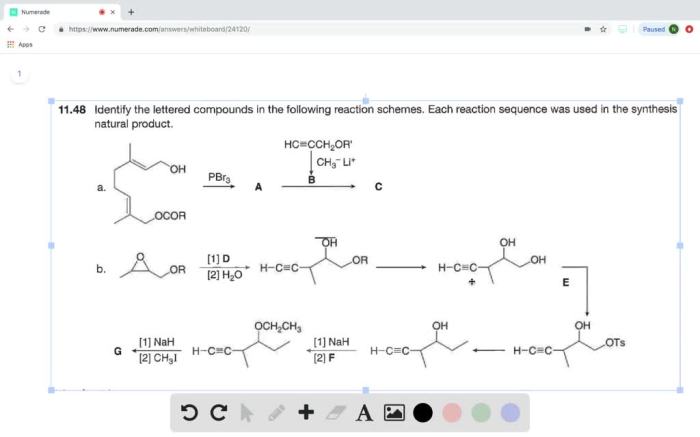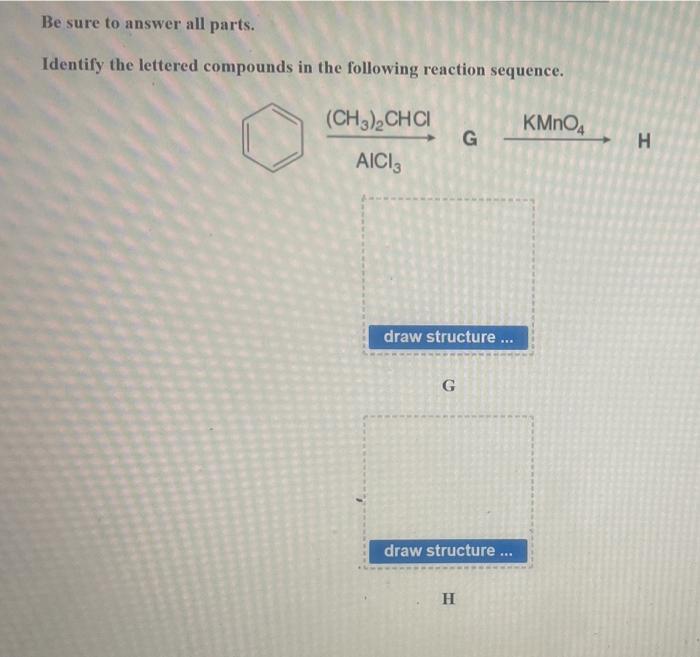Identify the lettered compounds in the following reaction sequence – Identifying lettered compounds in reaction sequences plays a pivotal role in organic chemistry, providing crucial insights into the mechanisms and outcomes of chemical reactions. This article explores the significance of identifying lettered compounds, examining the various methods employed for their identification, and delving into their applications in diverse fields such as organic synthesis, medicinal chemistry, and environmental chemistry.
To identify lettered compounds, chemists utilize a range of techniques, including functional group analysis, mass spectrometry, and nuclear magnetic resonance (NMR) spectroscopy. Each method offers unique advantages, allowing researchers to elucidate the structures of lettered compounds with varying degrees of accuracy and detail.
Identifying Lettered Compounds in Reaction Sequences

Identifying lettered compounds in reaction sequences is crucial in organic chemistry as it allows researchers to understand the mechanisms of reactions and design new synthetic pathways. Various methods are employed to identify these compounds, including functional group analysis, mass spectrometry, and nuclear magnetic resonance (NMR) spectroscopy.
Methods for Identifying Lettered Compounds
Functional Group Analysis
Functional group analysis involves identifying the presence of specific functional groups within the lettered compounds. This method relies on chemical tests and spectroscopic techniques to determine the characteristic functional groups present. By matching these functional groups to known reaction pathways, researchers can deduce the identity of the lettered compounds.
Mass Spectrometry
Mass spectrometry is a powerful tool for identifying lettered compounds based on their molecular weights. By measuring the mass-to-charge ratio of ions produced from the compound, researchers can determine its molecular weight and elemental composition. This information can be used to identify the compound by comparing it to known molecular weights and elemental compositions.
Nuclear Magnetic Resonance (NMR) Spectroscopy
NMR spectroscopy provides detailed information about the structure of lettered compounds. By analyzing the chemical shifts and splitting patterns of the protons and carbons in the molecule, researchers can determine the connectivity of atoms and identify the specific functional groups present.
This information can be used to deduce the identity of the lettered compounds.
Applications of Identifying Lettered Compounds, Identify the lettered compounds in the following reaction sequence
Identifying lettered compounds is essential in various fields, including organic synthesis, medicinal chemistry, and environmental chemistry.
Organic Synthesis
In organic synthesis, identifying lettered compounds allows researchers to understand the mechanisms of reactions and design new synthetic pathways. By knowing the identity of the lettered compounds, researchers can optimize reaction conditions, improve yields, and develop more efficient synthetic methods.
Medicinal Chemistry
In medicinal chemistry, identifying lettered compounds is crucial for understanding the structure-activity relationships of drug molecules. By identifying the lettered compounds in a drug molecule, researchers can determine its mechanism of action and design new drugs with improved efficacy and reduced side effects.
Environmental Chemistry
In environmental chemistry, identifying lettered compounds is important for understanding the fate and transport of pollutants in the environment. By identifying the lettered compounds in environmental samples, researchers can assess the risks posed by these pollutants and develop strategies to mitigate their impact on the environment.
FAQ Insights: Identify The Lettered Compounds In The Following Reaction Sequence
What is the significance of identifying lettered compounds in reaction sequences?
Identifying lettered compounds allows chemists to determine the structures of reactants, intermediates, and products in a reaction sequence, providing insights into the reaction mechanism and regio- and stereoselectivity.
How does functional group analysis aid in identifying lettered compounds?
Functional group analysis involves identifying characteristic functional groups within lettered compounds based on their chemical properties and spectroscopic data. This information helps determine the molecular structure and identity of the compounds.
What is the role of mass spectrometry in identifying lettered compounds?
Mass spectrometry measures the mass-to-charge ratio of ions produced from lettered compounds, providing information about their molecular weight and elemental composition. This data can be used to deduce the molecular structure and identify lettered compounds.



